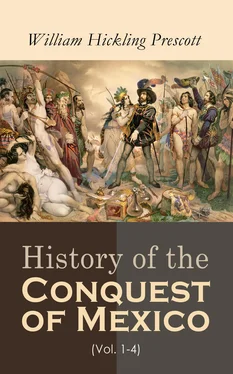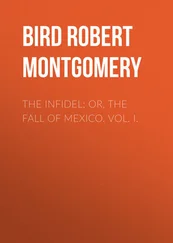Sahagun produced several other works, of a religious or philological character. Some of these were voluminous, but none have been printed. He lived to a very advanced age, closing a life of activity and usefulness, in 1590, in the capital of Mexico. His remains were followed to the tomb by a numerous concourse of his own countrymen, and of the natives, who lamented in him the loss of unaffected piety, benevolence, and learning.
Table of Contents
MEXICAN HIEROGLYPHICS—MANUSCRIPTS—ARITHMETIC—CHRONOLOGY—ASTRONOMY
IT is a relief to turn from the gloomy pages of the preceding chapter to a brighter side of the picture, and to contemplate the same nation in its generous struggle to raise itself from a state of barbarism and to take a positive rank in the scale of civilization. It is not the less interesting, that these efforts were made on an entirely new theatre of action, apart from those influences that operate in the Old World; the inhabitants of which, forming one great brotherhood of nations, are knit together by sympathies that make the faintest spark of knowledge, struck out in one quarter, spread gradually wider and wider, until it has diffused a cheering light over the remotest. It is curious to observe the human mind, in this new position, conforming to the same laws as on the ancient continent, and taking a similar direction in its first inquiries after truth,—so similar, indeed, as, although not warranting, perhaps, the idea of imitation, to suggest at least that of a common origin.
In the Eastern hemisphere we find some nations, as the Greeks, for instance, early smitten with such a love of the beautiful as to be unwilling to dispense with it even in the graver productions of science; and other nations, again, proposing a severer end to themselves, to which even imagination and elegant art were made subservient. The productions of such a people must be criticised, not by the ordinary rules of taste, but by their adaptation to the peculiar end for which they were designed. Such were the Egyptians in the Old World, [143]and the Mexicans in the New. We have already had occasion to notice the resemblance borne by the latter nation to the former in their religious economy. We shall be more struck with it in their scientific culture, especially their hieroglyphical writing and their astronomy.
To describe actions and events by delineating visible objects seems to be a natural suggestion, and is practised, after a certain fashion, by the rudest savages. The North American Indian carves an arrow on the bark of trees to show his followers the direction of his march, and some other sign to show the success of his expeditions. But to paint intelligibly a consecutive series of these actions—forming what Warburton has happily called picture-writing [144]—requires a combination of ideas that amounts to a positively intellectual effort. Yet further, when the object of the painter, instead of being limited to the present, is to penetrate the past, and to gather from its dark recesses lessons of instruction for coming generations, we see the dawnings of a literary culture, and recognize the proof of a decided civilization in the attempt itself, however imperfectly it may be executed. The literal imitation of objects will not answer for this more complex and extended plan. It would occupy too much space, as well as time in the execution. It then becomes necessary to abridge the pictures, to confine the drawing to outlines, or to such prominent parts of the bodies delineated as may readily suggest the whole. This is the representative or figurative writing, which forms the lowest stage of hieroglyphics.
But there are things which have no type in the material world; abstract ideas, which can only be represented by visible objects supposed to have some quality analogous to the idea intended. This constitutes symbolical writing, the most difficult of all to the interpreter, since the analogy between the material and immaterial object is often purely fanciful, or local in its application. Who, for instance, could suspect the association which made a beetle represent the universe, as with the Egyptians, or a serpent typify time, as with the Aztecs?
The third and last division is the phonetic , in which signs are made to represent sounds, either entire words, or parts of them. This is the nearest approach of the hieroglyphical series to that beautiful invention, the alphabet, by which language is resolved into its elementary sounds, and an apparatus supplied for easily and accurately expressing the most delicate shades of thought.
The Egyptians were well skilled in all three kinds of hieroglyphics. But, although their public monuments display the first class, in their ordinary intercourse and written records it is now certain that they almost wholly relied on the phonetic character. Strange that, having thus broken down the thin partition which divided them from an alphabet, their latest monuments should exhibit no nearer approach to it than their earliest. [145]The Aztecs, also, were acquainted with the several varieties of hieroglyphics. But they relied on the figurative infinitely more than on the others. The Egyptians were at the top of the scale, the Aztecs at the bottom.
In casting the eye over a Mexican manuscript, or map, as it is called, one is struck with the grotesque caricatures it exhibits of the human figure; monstrous, overgrown heads, on puny, misshapen bodies, which are themselves hard and angular in their outlines, and without the least skill in composition. On closer inspection, however, it is obvious that it is not so much a rude attempt to delineate nature, as a conventional symbol, to express the idea in the most clear and forcible manner; in the same way as the pieces of similar value on a chess-board, while they correspond with one another in form, bear little resemblance, usually, to the objects they represent. Those parts of the figure are most distinctly traced which are the most important. So, also, the coloring, instead of the delicate gradations of nature, exhibits only gaudy and violent contrasts, such as may produce the most vivid impression. “For even colors,” as Gama observes, “speak in the Aztec hieroglyphics.” [146]
But in the execution of all this the Mexicans were much inferior to the Egyptians. The drawings of the latter, indeed, are exceedingly defective, when criticised by the rules of art; for they were as ignorant of perspective as the Chinese, and only exhibited the head in profile, with the eye in the centre, and with total absence of expression. But they handled the pencil more gracefully than the Aztecs, were more true to the natural forms of objects, and, above all, showed great superiority in abridging the original figure by giving only the outline, or some characteristic or essential feature. This simplified the process, and facilitated the communication of thought. An Egyptian text has almost the appearance of alphabetical writing in its regular lines of minute figures. A Mexican text looks usually like a collection of pictures, each one forming the subject of a separate study. This is particularly the case with the delineations of mythology; in which the story is told by a conglomeration of symbols, that may remind one more of the mysterious anaglyphs sculptured on the temples of the Egyptians, than of their written records.
The Aztecs had various emblems for expressing such things as, from their nature, could not be directly represented by the painter; as, for example, the years, months, days, the seasons, the elements, the heavens, and the like. A “tongue” denoted speaking; a “footprint,” travelling; a “man sitting on the ground,” an earthquake. These symbols were often very arbitrary, varying with the caprice of the writer; and it requires a nice discrimination to interpret them, as a slight change in the form or position of the figure intimated a very different meaning. [147]An ingenious writer asserts that the priests devised secret symbolic characters for the record of their religious mysteries. It is possible. But the researches of Champollion lead to the conclusion that the similar opinion formerly entertained respecting the Egyptian hieroglyphics is without foundation. [148]
Читать дальше












